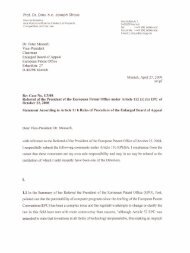Assessing the Obstacles to Industrialisation: The ... - Innovation
Assessing the Obstacles to Industrialisation: The ... - Innovation
Assessing the Obstacles to Industrialisation: The ... - Innovation
You also want an ePaper? Increase the reach of your titles
YUMPU automatically turns print PDFs into web optimized ePapers that Google loves.
zzStephen H. Haberand 30 years. In 1893 <strong>the</strong> government declared that all new industriescapitalised in excess of 2j0,ooo pesos were exempt from direct federaltaxes and from cus<strong>to</strong>ms duties on <strong>the</strong> machinerv and o<strong>the</strong>r materialsneeded <strong>to</strong> erect <strong>the</strong>ir fac<strong>to</strong>ries. <strong>The</strong> required minimum capitalisation waslowered <strong>to</strong> roo,ooo pesos in I s98.j8A few enterprises were able <strong>to</strong> do evenbetter in <strong>the</strong>ir negotiations with <strong>the</strong> Diaz government. It sometimesgranted firms <strong>the</strong> sole right <strong>to</strong> tax-exempt status within a particularproduct line. In effect, in order <strong>to</strong> promote industrialisation in anextremely difficult environment, <strong>the</strong> government was setting up officiallysanctioned and subsidised monopolies.Besides <strong>the</strong> development of inefficient, highly protected industry, <strong>the</strong>o<strong>the</strong>r major feature of this wave of Mexican industrialisation was <strong>the</strong>tendency of manufacturing <strong>to</strong> be extremely concentrated. Within anygiven product line a few large firms controlled <strong>the</strong> lion's share of <strong>the</strong>market. In steel, glass, soap, paper and dynamite production, single firmsheld monopolies or near-monopolies. Cigarette manufacturing wasdominated by two horizontally integrated giants (<strong>the</strong>re were actually threefirms, but <strong>the</strong> largest producer owned 50% of <strong>the</strong> s<strong>to</strong>ck in <strong>the</strong> nation'ssecond largest, effectively reducing <strong>the</strong> number of competi<strong>to</strong>rs <strong>to</strong> two). Inbeer and cement three big firms carved up <strong>the</strong> market. Even in cot<strong>to</strong>ntextile production, which is usually characterised by near-perfectcompetition, two firms claimed roughly 20 % of <strong>to</strong>tal national productionand almost all <strong>the</strong> production of fine, high-quality goods. A comparisonof four-firm concentration ratios indicates that Mexico's textile industrywas 60 % more concentrated than Brazil's and 280 % more concentratedthan that of <strong>the</strong> United States in r9ro."This non-competitive industrial structure evolved for two reasons.First, as has already been discussed, technological considerations limited<strong>the</strong> number of producers who could hope <strong>to</strong> prosper in Xlexico's shallowmarket. Secondly, <strong>the</strong> underdeveloped nature of Sfexico's financial sec<strong>to</strong>rmeant that a small group of financiers skilled at manipulating both <strong>the</strong>market and <strong>the</strong> state held an unusual degree of political and economicpower. <strong>The</strong>y were <strong>the</strong>refore able not only <strong>to</strong> demand (and receive) highlevels of protection from <strong>the</strong> government, but were also able <strong>to</strong> employa wide arsenal of anti-competitive weapons designed <strong>to</strong> create barriers <strong>to</strong>'"latsuo Yamada, '<strong>The</strong> Cot<strong>to</strong>n Industry in Orizaba: A Case Study of hiexican Laborand Industrialization During <strong>the</strong> Diaz Regime', unpubl. I\IX diss., university ofFlorida, 1965,p. 49.'' For a more complete discussion of industrial concentration and <strong>the</strong> creation of barriers<strong>to</strong> entry see Haber, Industry and L7nderdeuelopment, chs. 4 and 6. For an analysis ofconcentration ratios for <strong>the</strong> textile industry see Stephen H. Haber, 'IndustrialConcentration and <strong>the</strong> Capital Alarkets: A Comparative Study of Brazil, Mexico, and<strong>the</strong> United States, 18jo-rgjo',Journal of Econon~ic His<strong>to</strong>ry, aol. 5 I (1991).





